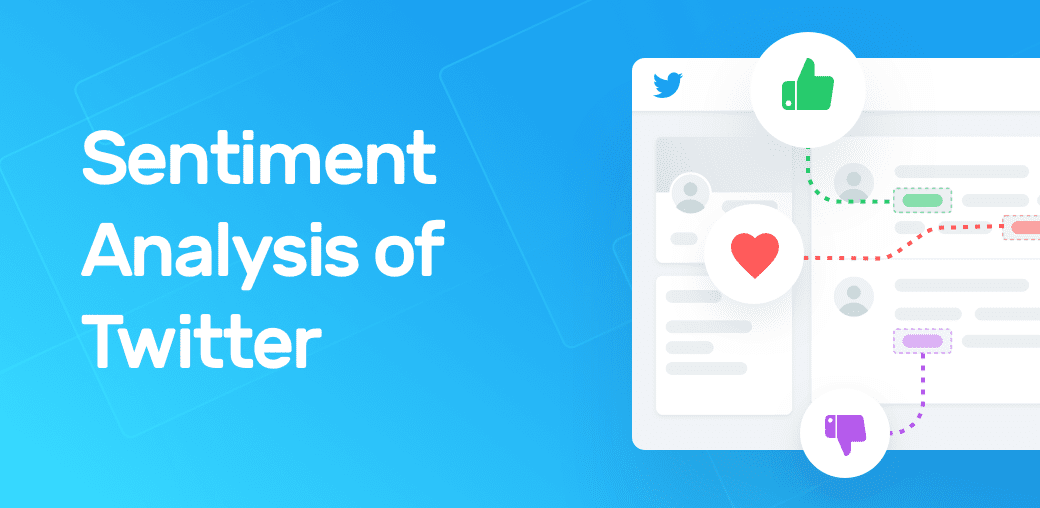In the vast social media landscape, Twitter stands out as a microblogging platform where millions express their thoughts in 280 characters or less. The challenge for businesses and individuals alike lies in understanding the sentiments behind these short messages. This is where Twitter sentiment analysis comes into play, offering valuable insights into the emotions and opinions circulating on the platform.
How Twitter Sentiment Analysis Works

1. Overview of Natural Language Processing (NLP)
At the core of Twitter sentiment analysis is NLP, a branch of artificial intelligence that enables computers to understand, interpret, and generate human-like language. NLP algorithms analyze the language used in tweets, identifying patterns and sentiments.
2. Importance of Machine Learning Algorithms
Machine learning algorithms play a pivotal role in sentiment analysis, learning from past data to predict sentiments accurately. These algorithms evolve, adapting to changes in language usage and staying relevant in the dynamic Twitterverse.
3. Gathering and Preprocessing Data for Analysis
Before diving into sentiment analysis, the data must be collected and preprocessed. This involves removing irrelevant information, handling missing data, and ensuring the dataset is representative of the diverse Twitter user base.
Tools and Technologies
1. Popular Tools for Sentiment Analysis
Several tools facilitate sentiment analysis on Twitter, ranging from open-source options like NLTK and TextBlob to more advanced commercial solutions like Brandwatch and AIM Insights. These tools provide user-friendly interfaces for analyzing sentiments at scale.
2. Emerging Technologies in Sentiment Analysis on Twitter
As technology advances, so do the tools for sentiment analysis. Emerging technologies like deep learning and neural networks are enhancing the accuracy and efficiency of sentiment analysis on Twitter, offering a glimpse into the future of social media analytics.
Benefits of Twitter Sentiment Analysis
1. Business Insights and Decision-making
For businesses, understanding Twitter sentiments translates into actionable insights. Whether launching a new product or refining marketing strategies, sentiment analysis aids in making data-driven decisions that resonate with the audience.
2. Brand Reputation Management
Maintaining a positive brand image is crucial in the digital age. Twitter sentiment analysis allows businesses to monitor their online reputation, identify potential PR crises, and proactively address customer concerns.
3. Identifying Trends and Emerging Issues
Twitter is a real-time platform where trends emerge and fade rapidly. Sentiment analysis helps in identifying emerging issues, allowing businesses to stay ahead of the curve and adapt to changing consumer sentiments.
Challenges in Twitter Sentiment Analysis
1. Dealing with Sarcasm and Irony
Deciphering sarcasm and irony in tweets poses a challenge for sentiment analysis algorithms. The subtleties of language require advanced algorithms capable of understanding context and tone.
2. Addressing Language Nuances and Cultural Variations
Twitter is a global platform with users from diverse linguistic and cultural backgrounds. Sentiment analysis must account for language nuances and cultural variations to provide accurate results across regions.
3. Ensuring Accuracy in Sentiment Classification
The accuracy of sentiment analysis models is paramount. Ensuring that algorithms correctly classify sentiments avoids misinformation and supports the credibility of the insights derived from the analysis.
Real-world Applications
1. Case Studies of Successful Sentiment Analysis on Twitter
Numerous businesses have successfully leveraged X sentiment analysis to their advantage. Case studies showcase how companies have used these insights to improve customer satisfaction, enhance product development, and craft more effective marketing campaigns.
2. Impact on Industries such as Marketing, Finance, and Politics
The applications of X sentiment analysis span various industries. From guiding marketing strategies to predicting stock market trends and gauging public opinion in politics, the impact of sentiment analysis is far-reaching.
Improving Sentiment Analysis Accuracy
1. Continuous Learning Algorithms
To keep pace with the ever-evolving language on Twitter, sentiment analysis algorithms must embrace continuous learning. This ensures that models remain accurate and effective over time.
2. User Feedback Incorporation
Incorporating user feedback is essential for refining sentiment analysis models. Feedback from users helps in identifying areas for improvement and addressing the challenges posed by the dynamic nature of online communication.
3. Combining Sentiment Analysis with Other Data Sources
Combining sentiment analysis with other data sources is beneficial to enhance accuracy and context. Integrating social media data with broader analytics provides a more comprehensive understanding of consumer behavior.
Ethical Considerations
1. Privacy Concerns in Sentiment Analysis
While sentiment analysis offers valuable insights, it raises privacy concerns. Balancing the need for analysis with respect for user privacy is crucial to maintaining the ethical use of sentiment analysis on Twitter.
2. Avoiding Bias in Algorithmic Decision-making
Ensuring that sentiment analysis algorithms are free from biases is imperative. Addressing biases in data and algorithms contributes to fair and equitable results, preventing unintended consequences.
Future Trends
1. Integration with Emerging Technologies
The future of X sentiment analysis involves integration with emerging technologies like augmented reality (AR) and virtual reality (VR). These advancements will provide a more immersive understanding of user sentiments.
2. Enhanced Predictive Analytics Capabilities
As algorithms become more sophisticated, the predictive analytics capabilities of sentiment analysis will also evolve. Businesses can anticipate trends and consumer behavior with greater accuracy, staying ahead of market dynamics.
Conclusion
In conclusion, X sentiment analysis is a powerful tool for unraveling the social media pulse. Its impact on businesses, brand management, and decision-making cannot be overstated. As the digital landscape continues to evolve, leveraging sentiment analysis on Twitter will be crucial for staying informed and responsive.
For a firsthand experience of the power of sentiment analysis, request a demo from AIM Technologies today.
FAQs
What is the primary purpose of X sentiment analysis?
- X sentiment analysis aims to decipher and understand the emotions and opinions expressed in tweets, providing valuable insights for businesses, individuals, and researchers.
How accurate are sentiment analysis algorithms on Twitter?
- The accuracy of sentiment analysis algorithms varies, but continuous learning and user feedback incorporation contribute to improving their accuracy over time.
Can sentiment analysis on Twitter be applied to different industries?
- Yes, sentiment analysis on Twitter has diverse applications, ranging from marketing and finance to politics, helping industries make informed decisions based on public sentiments.
What challenges do sentiment analysis algorithms face on Twitter?
- Challenges include dealing with sarcasm and irony, addressing language nuances and cultural variations, and ensuring accurate sentiment classification in the dynamic online environment.
What are the future trends in Twitter sentiment analysis?
- The future involves integrating sentiment analysis with emerging technologies like augmented reality and virtual reality, enhancing predictive analytics capabilities for businesses.




